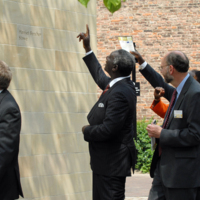
Opening of the Wilberforce Institute for the study of Slavery and Emancipation (WISE)
The Wilberforce Institute for the study of Slavery and Emancipation (WISE) was officially opened in Hull in 2006 in anticipation of the city's bicentenary commemorations. The University of Hull research centre specialises in researching the history of slavery, while also examining contemporary slavery and human rights abuses in the present day. The patron of the institute is Archbishop Desmond Tutu and the institute was opened by then President of Ghana, John Agyekum Kufuor. The WISE Humanitarian Wall commemorates historical and contemporary figures in the struggle against slavery, including Olaudah Equiano, Harriet Beecher Stowe and Nelson Mandela.
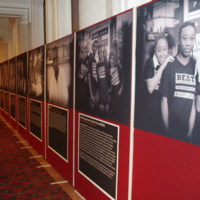
Freedom Roads
The Freedom Roads exhibition at Guildhall Art Gallery was one of several initiatives led by London Metropolitan Archives to mark the bicentenary. The exhibition featured contemporary photographic portraits of people of African origin whose work has contributed to the continuing struggle for human rights in different fields. Colin Prescod, Shirley Thompson, Eric and Jessica Huntley and Rudolph Walker were amongst the individuals featured. Others like the young people from BEAT (Black Experience Archive Trust) were engaged in a project to find out about significant people in their local community. Each person was photographed with an image of an object or place which has a special significance to them. The other part of the exhibition focused on relevant archival materials held by London Metropolitan Archives, including the South African Bill of Rights and a copy of the Constitution signed by Nelson Mandela, Cyril Ramaphosa, F. W. De Klerk and Roelf Meyer. Other material relating to slavery and abolition included a letter from John Julius, a plantation owner on the island of St. Kitts.
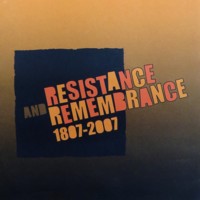
Resistance and Remembrance: Marking the 200th anniversary of the Parliamentary Abolition of the Transatlantic Slave Trade
Part of the British Museum's Atlantic Trade and Identity season, Resistance and Remembrance was a commemorative public day held at the British Museum on 25 March 2007, in association with the Royal African Society and Rendezvous of Victory. Placing a strong emphasis on resistance to the slave trade, the day included poetry readings, storytelling with Beyonder and H Patten, Bonnie Greer and Tony Sewell in discussion, and dramatised contemporary accounts of life as a slave. The day culminated in a Ceremony of Remembrance in the Museum's Great Court, featuring the telecast of a special message from Nelson Mandela.
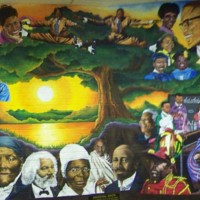
Ancestral Roots
Pontella Mason is one of Baltimore’s unsung visual artists. He has created murals for the Anacostia Community Museum, former President Jimmy Carter, and several other public organisations. His murals depict African American life and the diaspora. In 1999, he created the extensive mural Ancestral Roots, which depicts the antislavery heroes Harriet Tubman, Sojourner Truth, and Frederick Douglass, as well as Martin Luther King Jr., Malcolm X, Muhammad Ali, Notorious B.I.G., Tupac, Shirley Chisholm, and Marcus Garvey.
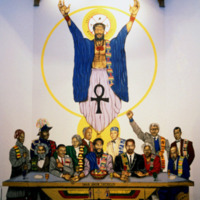
Last Supper
In 1990, muralist Maurice Myron Jenkins created an alternative version of Leonardo da Vinci’s 1494 fresco The Last Supper. The 30 by 19 foot mural depicts the last supper with a black Christ and 12 historical black figures as the prophets. Jenkins chose the Union Temple Baptist Church in Anacostia, Washington D.C. as his canvas because of its role in black history all the way back to its affiliation with Anacostia-resident Frederick Douglass in the 19th century.The mural includes the antislavery figures of Sojourner Truth and Frederick Douglass, as well as Marcus Garvey, Martin Luther King Jr., Rosa Parks, Elijah Muhammad, Malcolm X, Mary McLeod Bethune, Nelson Mandela, Booker T. Washington and W.E.B. Du Bois.
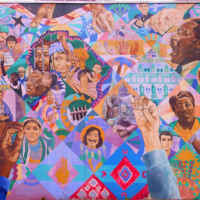
Freedom Quilt Mural
In 1988 David Fichter, with the help of volunteers, painted the Freedom Quilt Mural on the side of the American Friends Service Committee Building in Atlanta, Georgia. The mural was created as part of the Rainbow Coalition events during the 1988 Democratic National Convention. In February 2015 the building, owned by Georgia State University, was torn down – taking the mural with it. The quilted mural is thematically focused on non-violent heroes of history that struggled for justice and peace. It includes the faces of Mubarak Awad, Nelson Mandela, Winnie Mandela, Desmond Tutu, Oscar Romero, Rogoberta Menchu, Leonard Peltier, Andrew Goodman, Fannie Lou Hamer, Daniel Berrigan, Martin Luther King Jr., Rosa Parks, Mahatma Gandhi, and Lucretia Mott. It also includes the antislavery figures of Frederick Douglass and Harriet Tubman. Tubman points towards the North Star. Multi-racial hands stitch the quilt together, joining heroes (both famous and unknown) from all strands of history.
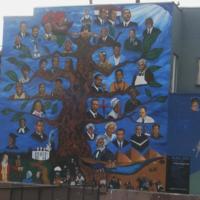
Black Seeds
In 1991, a group of artists – Eddie Orr, David Mosley, William T. Stubbs, Norman Maxwell and Michael McKenzie – collaborated to paint “Black Seeds” on an empty wall in Leslie N. Shaw Park on Jefferson and 3rd Avenue in Los Angeles. The idea for the mural, which appears as an African American tree of life, came from Vietnam veteran and local activist Gus Harris Jr. He recalled how little he learned about African American history in school. He wanted to create a public mural about black individuals who made an important contribution to society.The mural was created under the Social and Public Art Resource Center's 1990-91 “Neigborhood Pride: Great Walls Unlimited” mural program and features the antislavery leaders Harriet Tubman and Frederick Douglass, as well as Booker T. Washington, Thurgood Marshall, Mary McLeod Bethune, Malcolm X, George Washington Carver, Paul Robeson, Stevie Wonder, Shirley Chisholm, Martin Luther King Jr., and Jesse Jackson. The mural was restored by Moses X. Ball to include Barack Obama after 2008. The original canvas upon which the mural was based hangs in Oaks Jr. Market Corner Store at 5th and Jefferson.
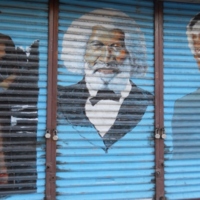
Tubman, Douglass, Mandela
This mural was created in 2008 by an unknown artist. Painted on a storefront on Ralph Avenue in Brooklyn, it depicted Harriet Tubman, Frederick Douglass and Nelson Mandela. As of 2014, it no longer existed.
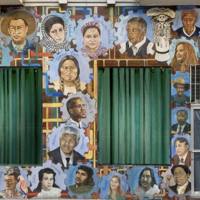
La L.ucha Continua/The Struggle Continues
This mural was painted on 3260 23rd St, between Mission and Capp Streets, in San Francisco by Susan Caruso Green, and was a community collaboration between muralists and local residents. It brings together faces from global history who have fought for civil rights, including the antislavery leader Harriet Tubman, Nelson Mandela, Gandhi, Mumia Abu-Jamal, Malcolm X, and Martin Luther King Jr.
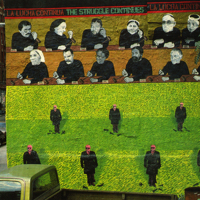
The Last Judgement
This mural, part of a wider series called La Lucha Continua/The Struggle Continues, is split into two halves. The bottom half shows anonymous arms merchants in suits, and the top portrait shows portraits of local residents alongside the leaders Nelson Mandela, Daniel Ortega, Robert F. Williams and the abolitionist Harriet Tubman, among others.
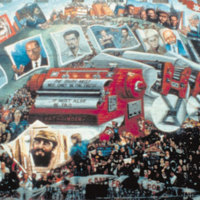
Pathfinder Mural
In 1988, Mike Alewitz designed and began to direct the creation of Pathfinder Mural in New York City’s West Village. The mural, measuring 79 x 85 feet, was an international collaboration of 80 artists from 20 different countries including Argentina, Canada, Iran, New Zealand, Nicaragua and South Africa. At its dedication, it was hailed as one of the largest political murals in the world. In 1987, Alewitz had approached the leaders of the Socialist Workers Party (SWP), of which he was a member, and proposed that Pathfinder Press sponsored a mural for its Charles Street building. The party approved both the project and his concept of the mural: a celebration of the revolutionary struggles in Cuba, Grenada, Nicaragua and South Africa, as well as in America. The central image of the mural is a large red printing press. The faces of Fidel Castro, Che Guevara, Malcolm X, Karl Marx, and Nelson Mandela loop around it. The abolitionists Frederick Douglass, Harriet Tubman and Sojourner Truth also feature. During the creation of Pathfinder Mural, the National Endowment for the Arts withdrew funding from several controversial projects, prompting a debate on free speech and censorship. For the first few months of this mural's creation, work continued without incident. But in 1989, Patrick Buchanan, a conservative commentator, vilified the mural in the Washington Times, calling it a “six-story shrine to communism, a Marxist Mount Rushmore in Greenwich Village." As the mural neared completion, the dialogue between Alewitz and the SWP started to break down. Alewitz was blocked from attending the mural dedication ceremony on November 19, 1989. During December, vandals threw glass bottles filled with white paint at the mural. In 1996, the mural was removed in order to repair cracks in exterior wall of the Pathfinder building, and by 2003, the building on which Pathfinder Mural was housed was sold for around $20 million.
![Don Rodgers, Our Brothers and Sisters, 100th and Halsted Streets [Black Neighborhood], Chicago, 1984.jpg Don Rodgers, Our Brothers and Sisters, 100th and Halsted Streets [Black Neighborhood], Chicago, 1984.jpg](https://486312.frmmmguz.asia/files/square_thumbnails/ade8cb4554aca77fae33825bf55434dc.jpg)
Our Brothers and Sisters
Titled Our Brothers and Sisters, this mural depicts figures of black history, including the abolitionist Frederick Douglass and also Harold Washington, Martin Luther King Jr., Booker T. Washington, Malcolm X, W.E.B. Du Bois, and Louis Armstrong.